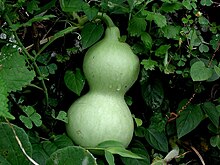The Chitarero were an indigenous Chibcha-speaking people in the Andes of north-eastern Colombia and north-western Venezuela. They were responsible for the death of the German conquistador Ambrosius Ehinger in 1533 by means of poisoned arrows.
 A calabash gourd or chitarero in the indigenous language, for which the Spanish named the Chitareros | |
| Regions with significant populations | |
|---|---|
| Norte de Santander, Santander, Táchira, | |
| Languages | |
| Chibcha, Colombian Spanish, Venezuelan Spanish | |
| Religion | |
| Traditional religion, Catholicism | |
| Related ethnic groups | |
| Lache, U'wa, Muisca, Guane |
At the time of the Spanish conquest of the Chibchan Nations, their territory ranged from present-day Táchira (Venezuela) to the northwest and south of Norte de Santander Department and the northeast of Santander Department (Colombia).[1] The Chicamocha River formed a southern boundary, the Valegra a southwestern, and the Surata a southeastern.[2] One of their settlements became the Colombian town of Chinácota; they were primarily known in the area of Pamplona, Colombia. At the refoundation of Pamplona in 1549 there were said to be 200,000 in the area.[3]
They were called "Chitareros" by the Spanish, because of the general custom that the men had to carry hanging from the waist a calabazo or totumo (calabash gourds) with maize wine or chicha as the Spanish called it. Asking what the thing they carried was called, the natives responded that it was a chitarero.
They traded with other peoples in the region, including the Muisca, the Guane and Lache.
References
editBibliography
edit- Moreno González, Leonardo (2011). "Paisaje y poblamiento del nororiente andino colombiano: la etnia de los Chitareros en el siglo XVI" (PDF). Fermentum (in Spanish). 009 - Nº 25.
- Simón, Pedro (1861) [1560]. The expedition of Pedro de Ursúa & Lope de Aguirre in search of El Dorado and Omagua in 1560 - 1: translated from Pedro Simon's sixth historical notice of the conquest of Tierra Firme Volume 28 of 1: Works. Hakluyt Society.